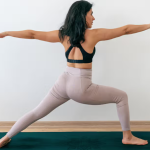As a society, we give expecting mums a lot of focus. There’s pregnancy yoga, an array of body therapies, pampering sessions and baby showers. The birth itself is the spotlight. We make birth plans, go to active birth classes and everyone is really excited about the due date. All this energy disperses after the little one is earthside. Partners go back to work. Doulas and midwives no longer visit. Friends and family return to their lives. A mum is left on her own with a brand new baby, most of the time feeling absolutely out of her depth.
Here’s how to talk to that mum, in and out of class:
- Help her adjust to her new body shape
- Help talk to her about her pelvic floor
- Teach her some breathing techniques
- Give her the skinny on what to do after a c-section
- Explain why antenatal yoga before 6 weeks may not help
- Suggest a checkup on her tummy for muscle separation
- See if she needs ideas for quick, nutritious snacks she can make with one hand
- If you know any reliable postnatal doulas, share their details with her.
- Be observant. Does she look sad and down consistently? Be diplomatic but if needed, suggest psychological support.
- Don’t make her baby the focus. Focus on HER.
To be a yoga teacher is a vocation. It is more than showing how to perform a complex stretch correctly. To many of us, it is about building mini-communities. It is about helping our students achieve both physical and emotional health. A good yoga instructor usually has regulars that come back for years. It is especially true for those of us who teach pregnant and postnatal yoga. We become trusted advisors – our recommendations and tips matter.
Things teachers hear from their pre and postnatal students can range from:
- “When I was in labour, I heard your voice”.
- “I used that breathing technique you taught me”.
- “I remembered one of the positions you taught and used it”!
The same is true for postnatal students coping with new body shapes. Mums with children in their teens can still recall cruel or unkind words from an unsympathetic teacher. Personally, when visiting my parents, three months after the birth of my son, I went to a local postnatal class. When I tearfully confessed to feeling flabby and weak after my emergency c-section during the class-closing circle, the teacher curtly observed “It is important to strive hard to achieve a natural birth. It is equally important not to let yourself go after the birth.” Needlessly to say, I never returned to that class.
Each person arrives in your class for a reason, whether we know it or they know it. Don’t attempt to be wiser/more experienced than you are. Being yourself is best. Admit to gaps in knowledge. Research questions you couldn’t answer and return to the topic next week. If you don’t have children of your own and never birthed, you still can lend a sympathetic ear. It is better to listen than give unsolicited advice. If she does ask you for your opinion, be tactful and diplomatic. If you do have babies, this is even more important – stay neutral and grounded. It is so easy to get lost in your own experience when talking to other mums!
I feel that yoga class fulfills more than one need for a postnatal mum. It gives them gentle physical activity. It gives time away from their home and all the demands at home. There is the internal space that yoga gives, something postnatal mums desperately need. Finally, there is a community of individuals who are all in the same boat – potential new friends. And there is you, giving support, not only in downward dog.
First, listen. Then listen more.













